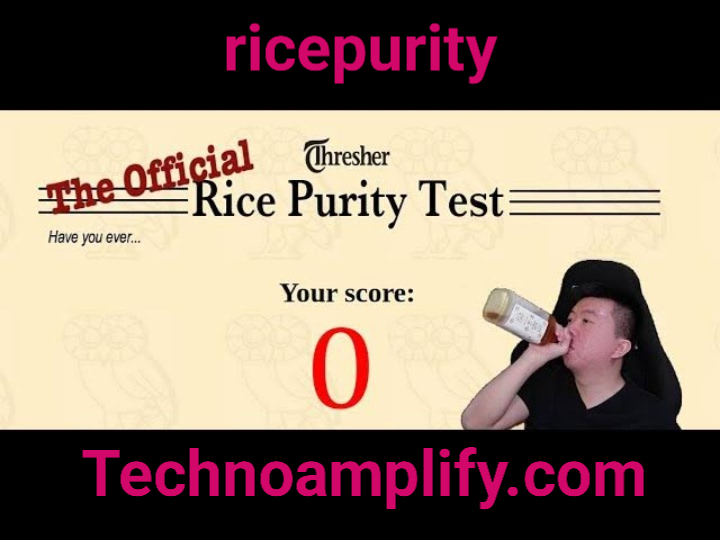Introduction: Understanding the Rice Purity Test and Its Significance
The Rice Purity Test, originally created by Rice University students, has evolved into a popular online quiz that has gained widespread attention, particularly among young adults and college students. With its playful tone, the test provides a set of questions that assess an individual’s experiences with various aspects of life, often touching on themes like relationships, alcohol, drugs, and other social behaviors. Though the Rice Purity Test can be seen as a fun and light-hearted way to evaluate one’s “purity,” it also offers deeper insights into how societal norms and individual choices shape our understanding of purity and morality.
This test involves 100 questions, and the results are presented as a score between 0 and 100. The lower the score, the more experiences an individual has had, while a higher score typically means fewer experiences with activities that the test deems as “impure.” While some see it as an entertaining conversation starter, others question the validity of such a measure, suggesting that the test may inadvertently promote shame or judgment over personal experiences.
In this article, we will delve into the origins of the Rice Purity Test, examine how it works, explore its cultural significance, and discuss both the positive and negative impacts of taking the test. Whether you’re a Rice University student or someone curious about its implications, understanding the Rice Purity Test provides a deeper look into our societal views on purity, morality, and personal growth.
The Origins of the Rice Purity Test: Where It All Began
The Rice Purity Test was first developed in the early 1980s at Rice University, a private research institution in Houston, Texas. Originally created by a group of students as a playful way to bond and share personal experiences, the test quickly gained traction within the university and eventually spread beyond its walls. What started as an inside joke among Rice students turned into a viral phenomenon as the internet gained popularity in the late 1990s and early 2000s.

The Rice Purity Test was designed to be a comprehensive survey of different activities that a typical college student might encounter during their time at university. It covers a range of topics, from relationships and sexual experiences to drug use, criminal activity, and even more lighthearted items like “streaking” or attending a frat party. The test’s structure, with questions written in a checklist format, makes it easy to score, with a person’s final “purity score” reflecting how many experiences they have had compared to a theoretical ideal of “purity.”
Over time, the Rice Purity Test became a way for students to gauge how “innocent” or “experienced” they were in comparison to their peers. As more universities and high schools adopted the quiz, it became a pop culture reference in online communities, sparking debates and discussions about what it means to be “pure” in today’s society.
Today, the Rice Purity Test is often shared on social media platforms like Facebook, Instagram, and Twitter. Some people take the quiz to have fun and engage with friends, while others approach it with a more serious mindset, reflecting on their personal experiences and how they align with the test’s expectations.
How the Rice Purity Test Works: A Deep Dive into the Quiz
The Rice Purity Test consists of 100 questions that cover various aspects of life. The questions are designed to be humorous, but they also touch on some controversial or sensitive topics. The primary objective of the test is to ask participants about their experiences with things like drugs, alcohol, relationships, and sexual activity. It’s important to note that the test does not measure morality in any definitive way; rather, it simply provides a snapshot of a person’s experiences relative to others.

For each of the 100 questions, participants can answer “yes” or “no,” based on whether they have engaged in the particular activity or not. At the end of the test, participants receive a score, which reflects how many of the experiences listed they have participated in. A score of 100 means the participant has avoided most of the activities mentioned in the quiz, while a score closer to 0 suggests a greater number of experiences considered outside of conventional social norms.
While the test can be seen as a playful activity, it also opens up discussions about what behaviors are considered acceptable in different cultures and communities. For example, certain questions about alcohol consumption or sexual behavior may be viewed differently in conservative versus liberal circles. The questions are purposefully designed to be open to interpretation, making the test both a fun social activity and a tool for exploring personal boundaries.
One of the more controversial aspects of the test is its inherent judgment. Since it categorizes behaviors as either “pure” or “impure,” it may unintentionally reinforce societal norms that stigmatize those who engage in certain activities. For example, individuals who score low on the test might feel pressured to justify their actions, while those with higher scores may feel the need to defend their “innocence” against what others might perceive as naivety.
The Cultural Significance of the Rice Purity Test: How It Reflects Society
The cultural significance of the Rice Purity Test lies in its ability to highlight societal attitudes toward purity and morality. The test has become a mirror of sorts, reflecting the values, pressures, and norms of different social groups. In a world where social media and peer pressure often dictate behavior, the Rice Purity Test provides a way for individuals to compare their experiences to others, even if the comparison is arbitrary or superficial. In Western cultures, the idea of “purity” is often tied to religious or conservative ideals, especially when it comes to topics like sexuality, drug use, and alcohol consumption. The Rice Purity Test taps into these cultural norms by framing certain behaviors as deviations from an idealized version of innocence. However, this viewpoint is not universal, and people from different backgrounds may interpret the test in vastly different ways.

For instance, in more liberal or progressive societies, the test’s implications about drug use, sexual experimentation, and alcohol consumption may seem less stigmatized. In contrast, more conservative communities may view the test’s questions as markers of moral decline. This divergence in interpretation underscores the idea that “purity” is not a fixed concept but rather a social construct that evolves with time and culture.
Additionally, the Rice Purity Test touches on broader issues related to adolescence and adulthood. For many, the quiz serves as a rite of passage, a way of gauging how they measure up to the expectations of their peers. It can also spark conversations about mental health, identity, and personal growth, as individuals reflect on how their experiences have shaped who they are today.
While the Rice Purity Test has faced criticism for promoting binary views of purity, it also serves as a tool for discussing how we navigate the complexities of adulthood. It’s a reminder that everyone’s journey is unique, and that the choices we make do not define our worth as individuals.
Conclusion: What the Rice Purity Test Really Reveals About Us
In conclusion, the Rice Purity Test is more than just a fun activity; it’s a reflection of how society views purity, morality, and individual choice. While some take it as a light-hearted game, others may find it to be a point of reflection on their own experiences. The test has become a symbol of how we measure ourselves against societal expectations, and how our perceptions of innocence and purity evolve over time.
Although the test may not provide any groundbreaking revelations, it does invite individuals to reflect on their personal journeys and question the values that shape their identities. It reminds us that everyone has a unique path, and there is no one-size-fits-all definition of purity. Whether you take the Rice Purity Test for fun, or use it as an opportunity for introspection, it is important to remember that personal growth and understanding come from within, not from a score on a quiz.
FAQs About the Rice Purity Test
1. What is the Rice Purity Test?
The Rice Purity Test is a fun, self-reflective quiz consisting of 100 questions that assess an individual’s experiences with a variety of behaviors, such as relationships, alcohol, drugs, and other social activities. The score reflects how many of the experiences a person has had.
2. Why was the Rice Purity Test created?
The test was originally created in the 1980s by students at Rice University as a way to bond and share personal experiences in a lighthearted manner. It quickly gained popularity among students and spread to other universities.
3. Is the Rice Purity Test an accurate measure of morality?
No, the Rice Purity Test is not a measure of morality or worth. It simply gauges the number of experiences a person has had according to a set of cultural norms and societal expectations.
4. How can I take the Rice Purity Test?
The test is available online, and you can take it on various websites that host the quiz. It takes just a few minutes to complete.
5. What does my score on the Rice Purity Test mean?
A higher score typically means fewer experiences with activities considered “impure” or unconventional, while a lower score suggests more experiences in these areas. However, the score should not be taken as a definitive judgment of your character or life choices.
This outline provides the structure for a long-form article on the Rice Purity Test, including
Also Read this : Everything You Need to Know About the Rice Purity Test: A Comprehensive Guide


